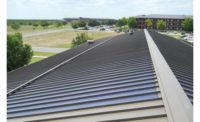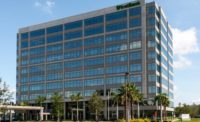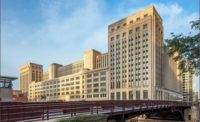It is no secret that the design and construction of a building envelope can have a substantial effect on a building’s energy performance. This is mainly due to the fact that the building envelope separates the exterior from the building’s interior. The idea of using glass as a major component for the building envelope has grown in popularity over time since it is good for natural light, ventilation and the aesthetics of the building.
Types of Energy-Efficient Glazing
The standard application in today’s market is insulated glass and more specifically insulated glass with a Low-E coating. Insulated glass features two panes of glass separated by an inert gas. The layer of gas disperses heat transfer, which makes the window more energy efficient. These types of glass are applied in both residential and commercial spaces. From there, other improvements can be added into the glass make up. These include argon filled insulating cavities, warm edge spacers, and additional Low-E coating applied on the room side of the insulated unit. Additionally, in the case of electrochromic glass, controlled tinting of the glass is can be by means of an electrified laminated assembly.
A warm edge spacer is an improved perimeter spacer that keeps the two lites of an insulated glass unit apart helping with condensation. Affecting the spacer bar of an insulating unit can reduce the amount of thermal transfer between the exposed face of an insulated unit and the interior conditions.
Low-emittance (Low-E) is a coating that increases a window or door's ability to diminish heat transfer, which can save heating and cooling costs. Low-E also effectively reduces the amount of ultraviolet light that enters the building, potentially damaging carpets, fabrics and drapes. An application that is newer, or becoming more specified, to the industry is the room side Low-E. In this application a second low-e coating is added to the interior side of the unit.
One of the more recently developed types of energy efficient glass is electrochromic glass, which is also known as smart glass or dynamic glass. This is a glass used for windows, facades, curtain walls and skylights that can be tinted electronically and directly controlled by building occupants. Although it is pricier than other types of glass, it can reduce energy costs and provide architects with more design freedom. The electrochromic glass uses wiring and low voltage energy that can be tied into the building systems and programmed. It will allow light in at certain times to help the building mechanical systems or to reduce the amount of solar heat allowed in during certain seasons or over the course of the day. In addition to the potential to optimize solar heat gain, electrochromic glass can be used to reduce glare due to Visible Light Transfer and decrease the burden or need for interior electrical lighting improving the interior environment for workspaces, learning and other applications.
Residential vs. Commercial
The main difference between residential and commercial application will depend on the thickness of the actual glass. Both applications will rely on Low-E coatings and an insulated make up. Residential applications will focus on either a smaller air space or the glass will not be as thick. The reduced glass thickness is attributable to residential windows not having the same sizing and/or taking the same level of structural burden in application as does commercial glass.
As far as making improvements to the glass, argon filled insulated cavities and warm edge spaces are available in both applications. Triple-insulated glass and other specialized glass systems will usually not be applicable in residential projects due to the thickness of the material and are most viable in a commercial application due to the restrictions of the specific systems.
Energy Efficiency
Energy efficiency has become a driving focus when choosing glass in commercial projects. Every commercial building is aligned to either energy efficiency or building codes. As efficiency requirements and codes advance, there has been an effect on what types of glass are being used. The most current building codes have created an increase in performance requirements of the glass and affecting what types of glass can be applied. This product application and design selection has become an important and integral decision in every project.
When it comes to building codes and specified wall efficiency, performance requirements are applicable to the entire glazing system assembly. Glass is a major component of system performance as over the surface of a wall system, the glass will be the most exposed component to the exterior. This will create a barrier between the interior and exterior elements. In turn, making alignment of the performance values of the glass to the performance of the systems critical. For example, in St. Louis the prescriptive U-Value for systems is .38, while the average U-Value of a 1-inch insulated glass assembly with a Low-E coating is .29. If a specifier would specify or a contractor would take a standard off the shelf system and put that glass make-up in it, the system would not meet the 2018 IECC prescriptive energy requirement in St. Louis.
There are simple improvements and options for both systems and glass which allow for standardized systems to achieve the performance values required, but usually there is a need to combine improvements on both components as architectural design dictates the applicability of system solutions. In addition to the prescriptive requirements, many buildings and design teams are required to use building energy models to determine the actual system requirements needed. This requirement is applied when a building design does not fall within the limiting parameters defined in the energy code. In these cases, the U-Value requirements of the systems are specified or needed tend to be more stringent than those in the prescriptive energy code. Given this importance of glass to the performance of the exterior façade systems, there is a strong focus on glass performance in building design.
Another performance design aspect to keep in mind is condensation. While not an energy code requirement, there is an increased awareness of the effects of interior thermal design and the need to balance that with the performance of the building envelope. As an example, healthcare design is recognizing a benefit of higher humidity level in certain spaces. This increase in humidity places an additional focus on the condensation resistance of the system. Recognition of these interior awareness improvements lead to not only a need to improve the system U-Values, but also the introduction of additional unique glass and system improvements to support unique interior design conditions.
Glass Improvement Options
Specific to glass improvements, adding additional elements to the glass make-ups can help with its building performance focused energy efficiency.
Low-E coatings applied to glass will help in improving U-Value, ultimately translating to an improved insulated value of the exterior wall. These coatings also help with solar heat gain, which is a building code and design performance metric to be restricted to an allowable amount. Glass is the primary contributor to this code requirement and as such the coating has to be aligned to the applicable requirement. In addition to U-Value and solar heat gain, Low-E coatings have an impact on visual light transmitted (VLT).
Designing, in respect to VLT, can be difficult as coatings can be used to reduce the effects of glare on interior surfaces and display screens or monitors when the sun is hitting the glass, but these coatings will also restrict the amount of natural light into the space. Introducing secondary room-side Low-E coatings, if done correctly, can provide additional improvement to the assembly’s U-value, and not negatively affect the other glass performance values. By improving on a glazing assembly’s U-Value, this secondary coating is a long-lasting application that allows for adjustments in the mechanical needs of a building and translates into mechanical systems design savings and significant sustainable energy related savings.
Improving the glass by using insulating glass provides a limited but substantial value to the building as it only effects the U-Value, but does so as a major improvement. By adding argon gas into the air space cavity, the U-Value of the insulating unit is improved further and is a cost-effective means of improving glass and system performance. Argon gas in a 1-inch insulated glass unit will improve the assembly performance by approximately .04 to .05 points and this simple improvement can allow standard systems and glass to meet performance requirements. To go even further, adding a secondary insulated unit to an insulated glass assembly infill creates a triple insulated glass make-up. This increases the U-Value performance of a glass assembly and a second argon filled airspace can be added to these make-ups creating an even higher performing glass.
Insulating glass does bear an additional benefit in the form of acoustic betterment. In the past, monolithic glass or non-insulated units were used for building enclosures. With these types of glass, there is a large amount of acoustic transfer. The insulated glass improves the acoustic performance of the facade, which is a benefit to the owner and occupants. An additional acoustic improvement above simply creating an insulated glass assembly is that by off-balancing the lites (using two different thicknesses of glass), the acoustic performance of the glass assembly is enhanced with limited need for system revisions or any tangible aesthetic affects.
Installation and System
When it comes to installing the standard make-ups of glass, most systems are becoming more adaptable and are fairly uniform in accommodating increased thicknesses and unique make-ups, especially in curtainwall systems. This uniformity creates a standard knowledge base and applicable skill set to the standard installations. However, an installation concern is present when there is an increase in the thickness of glass or quantity of glass lites. For example, with triple insulated glass, there is a corresponding increase in the weight and deadload placed on the system components. The weight on the glass needs to be understood because this typically creates an added manpower or equipment burden, which can ripple into site logistics and installation planning combined with the added installation concerns. Glass weight needs to be reviewed early along with horizontal spacing and vertical spacing. Larger lites of glass can impact the system’s shapes and create the need for enhancing the system components to accept the added weight.
Closing
Understanding the importance of energy efficiency in glass design and selection as a primary component of the glazing system recognizes that the performance values of the glass are specifically affected by the actual system it is being installed into. There is a need to look at both the U-Value of the glass and the performance of system. When installing glass into a system it is essential for them to be compatible and for their unique component values aligned so that the envelope performance will meet code or specification. It is under this specific understanding that in order to address and comply with the most recent energy codes, in some or most markets, many applications require use of an argon filled airspace at a minimum glazing improvement.
As time moves on, using glass as a primary component in a building enclosure will remain as the positive impacts of natural light daylighting on interior environment and aesthetics are unique to glass and glass systems. Insulated glass will continue to be a valuable asset in helping buildings be energy efficient, along with help from argon filled insulating cavities, warm edge spacers and Low-E coatings. These additions, advancements and future advancements will continue to allow owners and design teams to create dynamic spaces and environments, while also addressing increased energy and thermal design needs and awareness.
All of the additional glass improvement options, such as room side Low-E, argon filled cavities, warm edge spacers, triple insulated and electrochromic glass all come at a premium cost. Some cost less than others, but accommodations like these are necessary. These added costs can be offset by the reduction in HVAC requirements and are better addressed early in a design process, while continuing to provide benefit to the owner over the lifespan of a building by means of energy savings.



